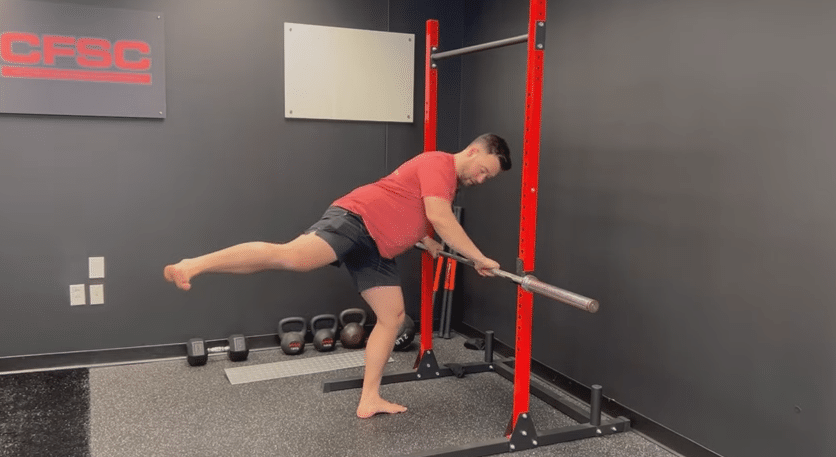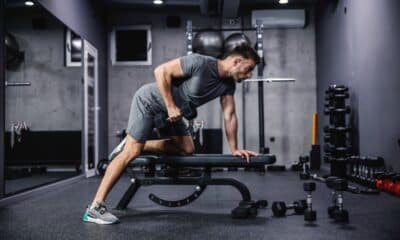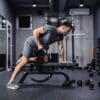Soaring into Health: Discover How Modern Airplanes Support Your Journey to Healthy Aging
Searching for an exercise that promotes movement, stability, and strength as you age? Let us introduce you to the hip airplane, a low-impact bodyweight exercise with incredible benefits for longevity and overall well-being.
Whether climbing stairs, playing tag with your grandkids, or looking to ease those persistent aches, the hip airplane is a game-changer. The best part? It requires no fancy equipment or gym membership, allowing you to practice it anytime and anywhere. Imagine fitting this simple yet effective movement into your daily routine, helping you stay nimble and ready for life’s twists and turns.
Here’s how to perform the hip airplane correctly:
1. Start by standing tall with your feet shoulder-width apart, a slight bend in your knees, and your core engaged—think of this as preparing your body for a balancing act.
2. Shift your weight onto one leg, ensuring that knee remains slightly bent. Lift the other leg straight out behind you, keeping your core tight.
3. Hinge at your hips, pushing them back as you lean your torso gently toward the ground. Maintain a neutral spine—the aim is to elongate through your spine, not to hunch.
4. From this position, rotate the lifted leg outward, allowing your core, hips, and torso to move together in harmony. Hold this position for a moment and feel the stretch.
5. Next, bring your hips back to the center, then rotate toward the supporting leg again, making sure everything moves as a unit.
6. Finally, return your hips to the center to complete one repetition.
Now that you’re equipped with the basic technique, let’s talk about why the hip airplane deserves a spot in your fitness routine as you gracefully age.
The hip airplane is more than just a quirky name—it’s a powerful exercise that enhances your functional movement patterns. This essential bodyweight move helps maintain strength, balance, and mobility as you age. Here are five compelling reasons to make hip airplanes a regular part of your weekly workouts:
1. Enhanced Hip Mobility and Flexibility
Your hips are crucial for everyday movements like walking, running, and bending, as certified personal trainer Avery Price reminds us. Unfortunately, inactivity and muscle weakness can lead to tight and discomforting hips over time. That’s where hip airplanes step in. They help you work on hip rotation—something we often overlook. Educator and trainer Lindsay Ogden highlights that this movement boosts flexibility in your hip flexors and glutes, reducing pain. By enhancing mobility, you’ll experience less joint stiffness, allowing you to remain active and content as you go about your day.
2. Improved Balance
Balance might not feel like a priority in your youth, but it’s something you’ll want to focus on as you age. Good balance is crucial for maintaining independence; without it, everyday activities like navigating stairs can turn into real challenges. Did you know that one in four seniors falls each year, and these falls are a leading cause of injuries among those aged 65 and older? The hip airplane can help. By balancing on one leg, you activate stabilizing muscles, assisting with pelvic alignment and preventing accidents. Strengthening your balance today is an investment in a safer and steadier tomorrow.
3. Stronger Glutes
Let’s face it—the glutes are the powerhouse of your body. They play a key role in everything from walking to picking up groceries. With hip airplanes, your glutes work overtime to stabilize your hips and perform movement. This translates into enhanced hip stability and stronger glutes. Plus, engaged glutes mean better stability in your lower body, which is essential for keeping your balance on uneven ground, whether you’re hiking or navigating your backyard.
4. A Stronger Core
Hip airplanes don’t just focus on your hips; they also light up your core. Engaging those deep core muscles helps you build a strong midsection, which is crucial for maintaining balance and stability. Whether it’s lean down to tie your shoe or bunkering down to lift your grandchild, a strong core makes those everyday tasks feel easier.
5. Better Posture
Having a robust core translates to improved posture—a significant benefit as we age. Poor posture can sneak up on us, resulting in rounded shoulders and a hunched spine. As we grow older, issues like muscle loss and decreased bone density can contribute to that unflattering forward tilt. The good news? Exercises like hip airplanes can help counteract this trend. By fortifying your core, you support your spine and maintain a youthful posture, allowing you to walk with confidence.
As you can see, remaining active and integrating exercises like hip airplanes is crucial for living independently and energetically in your golden years.
While hip airplanes pack in fantastic benefits, it’s essential to perform them with good form to maximize their advantages and avoid injuries. Here are four common mistakes to watch out for:
1. Arching or Rounding Your Back
When your back arches or hunches, you can place unnecessary strain on your spine.
*How to fix it:* Keep your spine neutral by aligning your head, neck, and tailbone in a straight line. Instead of looking up, gaze slightly ahead of your supporting foot to aid balance.
2. Allowing Your Leg to Hang Loosely
A relaxed back leg won’t activate essential muscles like your glutes and hips.
*How to fix it:* Extend your back leg deliberately, visualizing it as a strong line behind you. A little toe flex toward your shin can help keep things engaged.
3. Over-Bending or Locking Your Supporting Leg
Over-bending complicates hip rotations, while locking your knee can stress the joint.
*How to fix it:* Maintain a slight bend in your standing leg—think of it as a supportive bounce that helps with balance.
4. Allowing Your Torso to Collapse
If your torso collapses, it typically indicates a loss of core connection.
*How to fix it:* Engage your core by lifting your ribs away from your hips. Use a sturdy object for support if needed while working on perfecting your form.
It’s also good to know you can adjust hip airplanes to suit your fitness level. Whether you’re just starting your journey or ready to challenge yourself, these modifications and progressions can help.
Modifications
– Use Support: Hold onto a chair or wall as you practice to maintain proper balance.
– Limit Your Range of Motion: Start small—just a gentle rotation—and increase it as your stability improves.
– Rest Your Back Leg: Try placing your back leg on a yoga block to alleviate strain.
– Adopt a Quadruped Position: Perform the exercise on all fours to engage your core and control the leg movement.
Progressions
– Eliminate Support: Test your balance without holding onto something for an extra challenge.
– Add Resistance: Use weights or a resistance band to intensify the exercise. Maybe try holding a kettlebell or hugging a medicine ball.
– Slow Your Pace: Slow down your movements—take three seconds to rotate, then hold for 3-5 seconds at your furthest point.
– Widen Your Range of Motion: Gradually aim for complete, controlled rotations to improve your hip mobility and balance.
Consider integrating hip airplanes into your warm-ups—they’re an excellent way to prepare your joints and muscles for the activity ahead. Alternatively, they’re also a great addition to your cooldown after a heavy leg workout.
With consistent practice, you’ll not only feel empowered and stable but also positively impact your overall quality of life as you age gracefully. Keep going—you’ve got this!















